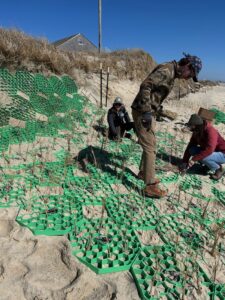Press Release: 5/16/2025
Nantucket pilot program seeks to mitigate coastal erosion

Nantucket town staff install cliff stabilizers on Madaket Beach as part of a pilot program to reduce erosion. (Photo courtesy town of Nantucket)
Over the past three years, erosion at Madaket Beach, which lies at the far southwest corner of Nantucket island, providing ocean access for the villages of Smith Point and Madaket, has reduced the beach’s coastal bank by 19 feet, threatening homes and the road along the shore.
Left unchecked, the erosion could overtake the intersection of Madaket Road and Ames Avenue and cut off the only public access route to Smith Point.
Nantucket experiences “one of the highest erosion rates in Massachusetts,” said Leah Hill, the town’s coastal resilience coordinator. “With that, there’s private property, homes … critical infrastructure that’s at risk.”
In an effort to mitigate the erosion, the town has developed a pilot program featuring a green, 22-by-22-inch honeycomb-like device referred to as a “cliff stabilizer,” produced by Coastal Technologies, a company based on Long Island in New York.
The honeycomb lattice is anchored into the sand by a screw mechanism and has spaces for beachgrass plugs, seeds and seedlings, which allows plants to develop a shoreline-stabilizing root network in a protected space. The stabilizers and vegetation capture wind-blown sand, helping to reform the beach as the plants grow. As sand builds, the anchors can be loosened so that the stabilizer can continue to capture sand. Once the roots have taken hold, the stabilizers can be removed without uprooting the new plant growth.
The encroaching ocean spurred Madaket and Smith Point homeowners to write letters to the town, asking for solutions to the ever-encroaching erosion. Hill and Nantucket Natural Resources Director Jeff Carlson saw an opportunity to try something new.
Nantucket unveiled a coastal resilience plan in 2021 that provides a framework for managing and countering the environmental impacts facing the island in the next century. The plan includes 40 recommendations for flood and erosion mitigation, with a section carved out for Madaket.
In March, the town began installing the cliff stabilizers at two locations: Madaket Beach and Dionis Beach on the northern side of the island. The town has designated a 60-by-27-foot space along the coastal bank and beach at each pilot program location. These areas are roped off and divided into four sections: cliff stabilizers and plugs; dune guards; plugs; and control. There are 2-foot buffer zones between each section.
With a crew of seven staff and volunteers, the installation process took about four hours on Madaket Beach and between seven and eight hours at Dionis, Hill said. Prior to installation, the Natural Resources Department had to file a notice of intent with the Nantucket Conservation Commission and consult with MassWildlife’s Natural Heritage and Endangered Species Program to determine wildlife impacts.
Hill said the purchase cost for the cliff stabilizers was roughly $10,000.
Town staff will measure elevation, plant density and survival, and erosion rates throughout the process to develop data points and baseline metrics. The stabilizers will remain at the beach through one full growing season.
Carlson said the stabilizers can be reused, which made them a particularly appealing product for a pilot program.
“You could pick it all up with relative ease and move it somewhere else,” he said, “and have kind of a roving project and address areas that are in need as best you can.”
Carlson and Hill said the stabilizers aren’t intended as a permanent fix, but a stopgap that allows for more extensive planning and consensus-building.
“Sometimes these little technologies buy you that time to plan and get to a longer-term plan,” Carlson said.
Written by Owen Page, MMA Communications Coordinator